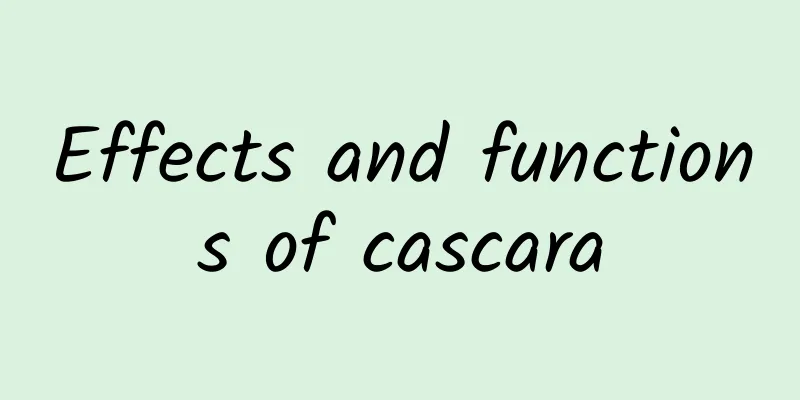Effects and functions of cascara

|
In modern life, everyone is very familiar with various Chinese herbal medicines, among which Rhamnus serrata is a very common one. So what are the effects and functions of Rhamnus serrata? Let’s take a look. [Alias] Rhamnus purpurogenus. [Source] Medicinal material source: The ripe fruit of Rhamnaceae. [Original form] Rhamnus serrata is a shrub or small tree, 5-8m high. Young branches are glabrous, twigs are purple-red or silver-gray, and have thorns at the branch ends; the terminal buds are oval with several scales, and the edges of the scales are ciliated. Leaves are opposite or alternate; petiole is 1-2.7cm long, with grooves on the upper side, sparse short hairs or nearly glabrous in the grooves; leaf blade is papery, elliptical, ovate-elliptical or ovate, 3-6.5cm long, 1.5-3cm wide, with short acuminate or obtuse tip, rounded or broadly cuneate base, serrated margin, glabrous on both sides. Flowers are solitary, dioecious, usually clustered in groups of more than ten on short branches or in the leaf axils of the lower part of long branches, with 4 bases; pedicels are 2-4cm long; male flowers have petals and small reduced stamens; female flowers have 3-chambered ovaries, long styles, and 3 shallow lobes. The drupe is spherical, black, with 3 separate cores and a persistent calyx tube at the base. There is a short groove at the base of the back of the seed and a groove at the top. The flowering period is from May to June, and the fruiting period is from July to September. [Habitat distribution] Ecological environment: Growing in mountain river valleys or hillside bushes at an altitude of 1200-1400m. [Chemical composition] The fruit contains 0.71%-1.13% anthracene derivatives, 3.22%-4.19% tannins, 0.92%-3.07% pectin, 8.85%-14.25% sugar, 0.96%-5.07% fructose, 134-545mg% vitamin C, 5.73%-5.89% anthocyanins, 17%-25% flavonoids, 0.25%-0.35% anthraquinone glycosides, and a trisaccharide with the structure of O-α-L-rhamnopyranosyl (1→3)-O-α-rhamnopyranosyl-(1→6)-D-galactopyranose. The bark of Rhamnus serrata contains tannins (0.57%-0.97%), sugars (3.34%-3.71%), and quinone compounds (1.93%-2.65%). Anthraquinone compounds: alaternin, chrysophanol, frangula-emodin and physcione, as well as emodin-8-O-β-gentibioside, emodin-8-O-glucoside and emodin-8-O-primveroside, and naphthylidene compounds sorinin, 6-methoxysorinin and 6-methoxy-sori-genin-8-O-β-D-glucopyranoside. 【Nature and flavor】 Bitter; Cool 【Functions and indications】Lubricates the intestines and promotes bowel movements. Mainly used for constipation caused by dry intestines; habitual constipation [Usage and Dosage] For oral use: decoction, 10-30g. 【Excerpt】 Chinese Materia Medica In fact, you will only know its benefits after practicing it. Just like the Chinese medicine Cascara sagrada introduced above, it turns out that Cascara sagrada can also treat some other diseases. Therefore, eating it in moderation has many benefits. |
<<: The efficacy and role of biting dogs
>>: The efficacy and function of medicinal dogtooth flower
Recommend
To prove that climate change is not terrible, they say that the warm period was the heyday of the Han and Tang dynasties.
The following article is from Voice of the Wind a...
In the middle of winter, how come wild ducks aren't afraid of getting their feet frozen when walking on the ice?
Wild ducks on the ice. Photo by Zhong Zhenyu &quo...
Which scorpion has high medicinal value?
Many people know something about scorpions. Scorp...
More and more young people are diagnosed with thyroid problems. To protect the "bow tie" in your body, start with these 4 things
The thyroid gland, a butterfly-shaped gland locat...
The efficacy and function of Eucalyptus globulus leaves
Eucalyptus globulus leaves are a type of traditio...
The efficacy and function of copper-footed clematis
Copper-footed Clematis is a very common Chinese m...
The efficacy and nutritional value of Morinda officinalis
Since ancient times, my country has emphasized th...
What are the medicinal values of Notopterygium
Qianghuo is also a Chinese herbal medicine, which...
Why is it so bitter when you take a bite of cucumber? That's the cucumber crying for help!
Some cucumbers are very sweet when you take a bit...
What is the correct way to eat Cordyceps?
Cordyceps, also known as Cordyceps sinensis, is o...
The efficacy and function of sassafras
Camphora is a famous traditional and commonly use...
The efficacy and function of Pyrola
Traditional Chinese medicine is very helpful in t...
Do animals grieve when their companions die?
In 2000, Karen McComb and others placed an elepha...
The efficacy and function of Vitex chinensis
I don’t know if you are familiar with Vitex negun...
Medicinal value of wolfberry and red dates
As the saying goes, a day is a day whether happy ...









